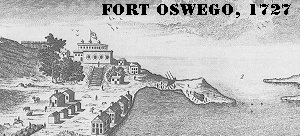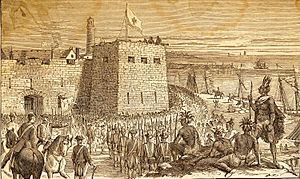Fort Oswego facts for kids
Fort Oswego was an important trading post in North America during the 1700s. It was located in the Great Lakes region. This fort became famous for a big battle between French and British forces in 1756. This battle was part of the French and Indian War.
The fort was first built in 1727. It was ordered by William Burnet, who was the governor of New York at the time. It was built next to an older blockhouse from 1722. That blockhouse had been a stop for French traders. Fort Oswego was made of logs and helped the British control the Great Lakes area.
In 1756, French and Native American forces easily defeated the British soldiers at the fort. More than 100 British soldiers died. Many were killed even after the fort had officially given up. The French captured 1,500 British prisoners. They then destroyed the fort completely. Today, the city of Oswego, New York covers the original site of the fort.
Contents
What Was Fort Oswego?
Many old stories about Fort Oswego can be confusing. This is because several forts were built in the same area over time. The original Fort Oswego was built on lower ground. It was on the northwest side of the Oswego River. This spot was good for canoes and small boats.
Other Forts Nearby
In 1727, a stone blockhouse was added. It was called Fort Burnet. Later, in 1741, a strong stone wall was built around it. This entire area was then called Fort Pepperrell. You can still find a marker for Fort Oswego on the northwest side of the river.
Other forts were also built close by:
- Fort Ontario was started in 1755. It was a wooden fort on the high ground across the river. It was also known as the East Fort.
- Fort George was added later. It was about half a mile southwest of Fort Oswego. People also called it Fort Rascal or the West Fort.
The French called Fort Oswego "Fort Chouaguen." Sometimes, when people talk about "Fort Oswego," they mean all these forts together. Today, only a marker is left of the original Fort Oswego.
Fort Ontario has been rebuilt many times. The U.S. Army stopped using it in the 1940s. Now, New York State Parks takes care of it. It is open for people to visit and learn about history.
The French and Indian War Battle
During the French and Indian War, a French general named Louis-Joseph de Montcalm led an attack. In August 1756, he arrived with 3,000 soldiers. His force included French soldiers, Canadian fighters, and many Native American allies.
First, Montcalm captured Fort Ontario. Then, he began attacking Fort Oswego. Fort Oswego was stronger, but it was now downhill from 120 cannons that the French had placed in the captured Fort Ontario. Montcalm fired many cannons at the fort. The British commander, Colonel Mercer, was killed during this attack. The British forces had to give up on August 15, 1756.
After the battle, Montcalm gave many of the British supplies to his Native American allies. He then destroyed Fort Oswego. He returned to Quebec with 1,700 British prisoners.
After the Battle
The site of Fort Oswego was used again later. It had shore batteries during the American Revolutionary War and the War of 1812. During the War of 1812, the British attacked it. However, the site was never built into a strong fort again. When people talk about "Fort Oswego" during the Revolutionary War, they are usually talking about Fort Ontario.
Today, the original site is remembered in Oswego, New York. You can find a marker at West First and Lake Street. Fort George was located where Montcalm Park is now. Fort Oswego was also used as a training site during World War I and World War II.
Fort Oswego is now a state historic site that you can visit.
Images for kids
See also
 In Spanish: Fort Oswego para niños
In Spanish: Fort Oswego para niños





